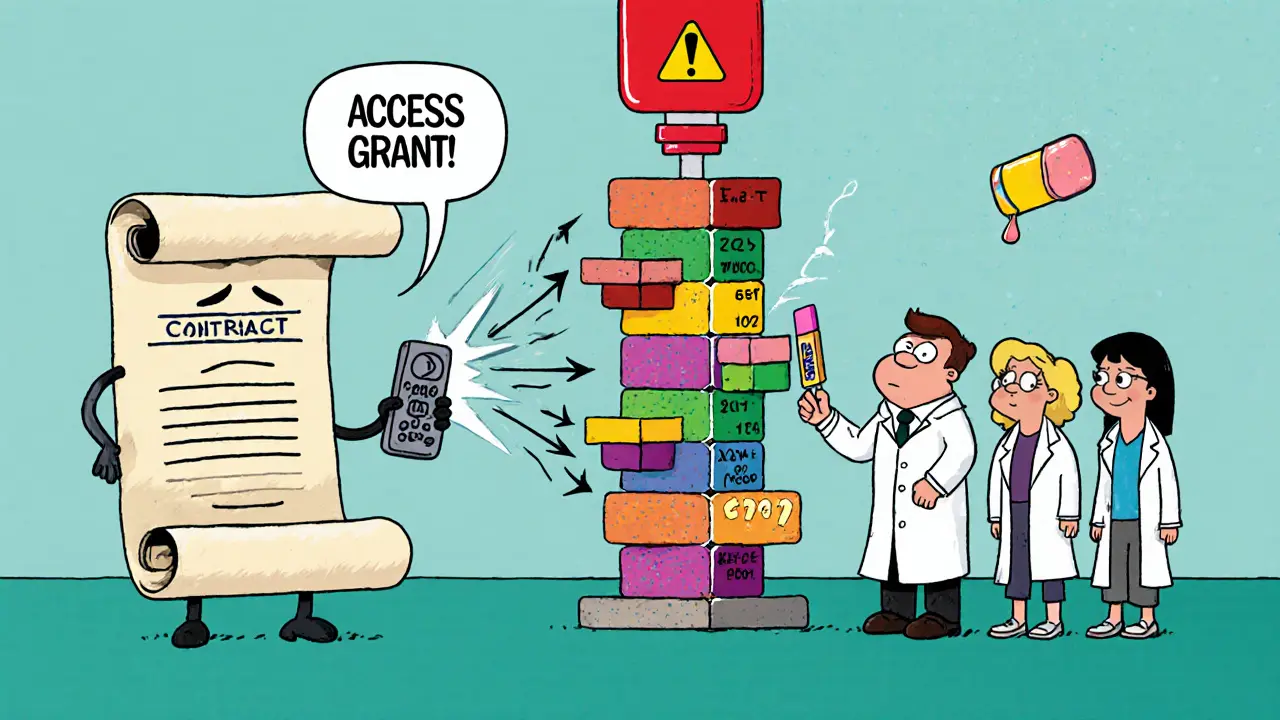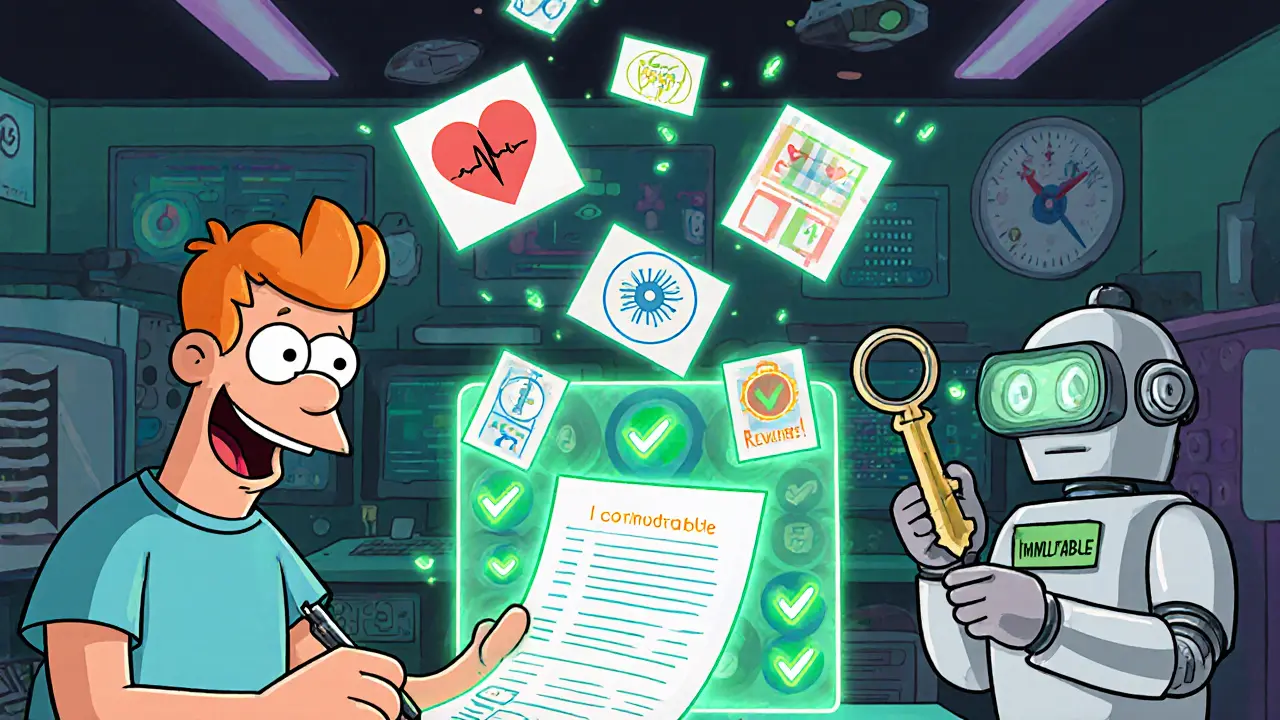Clinical Data Integrity Checker
How Blockchain Verifies Data
Blockchain creates a digital fingerprint (hash) for each data entry. Any change to the original data creates a completely different hash, making tampering immediately detectable.
Example: If the original blood pressure reading is "120/80", the blockchain records its hash as "a1b2c3...". If someone changes it to "115/75", the hash becomes "d4e5f6...". The system detects this mismatch instantly.
Verification Result
Enter data values to check if they would be detectable as tampered on a blockchain.
Imagine a clinical trial where every data point - from a patient’s first signed consent form to the final analysis - is recorded in a way that can’t be changed, hidden, or tampered with. No more lost records. No more selective reporting. No more doubts about whether the results were manipulated. That’s not science fiction. It’s what clinical trial data on blockchain makes possible today.
Right now, most clinical trials rely on centralized databases controlled by pharmaceutical companies or research institutions. These systems are vulnerable. Data can be altered after the fact. Missing entries go unnoticed. Negative results disappear. Patients have no idea how their data is used. Regulators struggle to verify claims. And when something goes wrong - which it often does - it’s hard to trace where the breakdown happened.
Blockchain changes that. It doesn’t store all the patient data itself. Instead, it logs every action: who accessed what, when, and why. Think of it like a public ledger that records every transaction in a bank, but for medical research. Every upload, every query, every consent update gets a time-stamped, unchangeable entry. That’s the core advantage: immutability.
How Blockchain Tracks Clinical Trial Data
Here’s how it works in practice. When a trial starts, the protocol - the exact plan for who gets what treatment, how data is collected, and how results are analyzed - is recorded on the blockchain. This isn’t just a PDF uploaded to a server. It’s a digital fingerprint locked into the chain. Once it’s there, no one can tweak the protocol after the trial begins without leaving a trace.
When a patient joins, their consent is encoded into a smart contract. This isn’t a paper form. It’s code. The contract automatically checks if the patient meets eligibility criteria, records their agreement, and sets rules for how their data can be used. If the researchers want to access the data later, they must trigger the contract. Every time, the blockchain logs it. The patient can see exactly when and why their data was accessed.
As data flows in - blood pressure readings, lab results, symptom logs - it’s stored off-chain for privacy and efficiency. But the blockchain records the hash (a unique digital signature) of each file. If someone tries to swap out a result or alter a value, the hash won’t match. The system flags it instantly. This prevents cherry-picking data to make a drug look more effective than it is.
BlockTrial, a real-world prototype developed by researchers, shows how this works. It uses the Ethereum network to run smart contracts. Patients use a simple web app to grant access. Researchers submit queries. Every interaction is recorded. No central authority controls it. No single point of failure. And everyone - patient, doctor, regulator, sponsor - can verify the chain of events.
Why Traditional Systems Fail
Traditional clinical trial databases are like locked filing cabinets. Only a few people have keys. If someone wants to hide a bad outcome, they can delete the file. If a sponsor wants to speed up approval, they might pressure researchers to re-analyze data until they get a ‘positive’ result. This isn’t rare. Studies show up to 50% of clinical trials never publish negative results. That’s not just unethical - it’s dangerous. Patients get treatments that look safe because the data hiding the risks was buried.
Blockchain fixes this by making everything visible. The ledger doesn’t care who you are. It doesn’t take orders. It just records. Regulators can audit the entire history of a trial in minutes, not months. Independent scientists can verify analyses without asking for permission. Patients know their data wasn’t manipulated.
And it’s not just about honesty. It’s about efficiency. Right now, trials get delayed because data from different sites doesn’t match. Paper forms get lost. Electronic systems don’t talk to each other. Blockchain doesn’t solve all integration problems, but it creates a trusted audit trail. If two sites report different numbers, the blockchain shows exactly when and how the data was entered - making reconciliation faster and more accurate.

Smart Contracts: The Automation Engine
The real power of blockchain in clinical trials isn’t just the ledger - it’s the smart contracts. These are self-executing programs that run automatically when conditions are met.
For example, a smart contract can be set up to release payment to a research site only after all patient data for a given visit is uploaded and verified. Or it can notify a patient when their data is used in a new analysis. It can even trigger alerts if data falls outside expected ranges - flagging possible errors or adverse events in real time.
One of the biggest wins? Informed consent. Right now, patients sign forms once and never hear from researchers again. With smart contracts, consent can be dynamic. A patient can say, “I’ll allow my data to be used for this trial, but only if it’s anonymized and never sold.” The contract enforces that. If a company tries to use the data for marketing, the contract blocks it. The patient gets notified. They can revoke access with a click.
This shifts power. Patients aren’t just subjects - they’re active participants with control. And that builds trust. When people know they own their data, they’re more likely to join trials. That means faster recruitment, more diverse populations, and better science.
Real-World Benefits: Integrity, Security, Interoperability
Four key improvements stand out when clinical trial data moves to blockchain:
- Integrity: Data can’t be altered. Every change is recorded. This ensures results reflect reality, not spin.
- Security: Data is encrypted and distributed. No single hack can wipe out a trial’s records.
- Interoperability: Different hospitals, labs, and sponsors can connect to the same system without needing matching software. They just need to follow the same protocol.
- Sharing and transfer: Data moves securely between parties. A researcher in Germany can access data from a clinic in Texas without waiting for paperwork or emails.
A 2023 study in the Business Process Management Journal found blockchain could reduce data fraud by over 70% in clinical trials. Another report from the National Center for Biotechnology Information noted it helps ensure analyses follow pre-registered plans - a major step toward stopping misleading results.
And it’s not just theory. Companies like MedRec and Chronicled are already piloting blockchain systems for patient data. The FDA has started exploring blockchain for verifying drug supply chains - a natural extension into trial data. Even big pharma, usually slow to adopt new tech, is watching closely.

Challenges Still to Solve
Let’s be clear: blockchain isn’t magic. It’s not ready to replace every trial database tomorrow.
First, it’s complex. Building smart contracts requires developers who understand both coding and clinical research. Integrating with old hospital systems is messy. Many clinics still use paper or 20-year-old software.
Second, privacy. While blockchain secures the log, the actual patient data is stored elsewhere. That data still needs strong encryption and strict access rules. The blockchain doesn’t make data anonymous - it just makes its usage transparent.
Third, regulation. No one has figured out how to legally govern a decentralized trial ledger. Who’s responsible if a smart contract fails? How do you enforce GDPR or HIPAA on a public blockchain? These are open questions.
And cost. Running on Ethereum isn’t free. Gas fees add up. Some systems are moving to private or hybrid blockchains to cut costs, but that reduces transparency. Finding the right balance is key.
The Future: Trust as Infrastructure
The goal isn’t to make every trial blockchain-based overnight. It’s to build a new standard - where trust isn’t based on reputation or contracts, but on code.
In five years, we might see a world where:
- Patients choose which trials to join via a blockchain-powered app that shows them exactly how their data will be used.
- Regulators get real-time access to trial logs, approving drugs faster because they know the data is clean.
- Independent researchers can re-analyze trial results without asking permission - because the raw data and analysis steps are all on the chain.
- Pharma companies compete not just on drug efficacy, but on how transparent their trials are.
That’s the promise. Clinical trial data on blockchain isn’t about fancy tech. It’s about fairness. It’s about science that can’t be corrupted. It’s about giving patients real control over their bodies and their data.
It’s not here yet. But it’s coming. And when it does, clinical research won’t just be better - it’ll be trustworthy.
Can blockchain prevent fake clinical trial results?
Yes, it makes it nearly impossible. Blockchain logs every data upload, query, and analysis step with a timestamp and digital signature. If someone tries to alter a result, the system detects the mismatch between the original data hash and the changed version. This creates a permanent, verifiable audit trail that regulators and independent scientists can check in real time.
Do patients own their data on a blockchain?
They can. Smart contracts let patients set rules for how their data is used - who can access it, for what purpose, and for how long. Patients can grant or revoke access anytime. The blockchain doesn’t store their medical records, but it records every permission change, so patients always know who’s using their data and when.
Is blockchain better than a regular database for clinical trials?
For transparency and integrity, yes. Regular databases can be edited, deleted, or hacked without leaving a trace. Blockchain records every action permanently. It doesn’t prevent bad data from being entered, but it makes hiding or altering it impossible. That’s a game-changer for trust and reproducibility.
Are there any real blockchain clinical trials running right now?
Most are still in testing, but several pilot programs exist. BlockTrial, developed by academic researchers, is one of the most documented. Companies like MedRec and Chronicled are also running small-scale trials using blockchain for data tracking and consent management. Large pharma companies are watching closely but haven’t rolled it out widely yet.
Why hasn’t blockchain replaced traditional systems yet?
Because it’s still expensive and complex. Setting up smart contracts, integrating with old hospital systems, and training staff takes time and money. Regulatory rules haven’t caught up. Also, most clinical trials don’t yet have the technical infrastructure to support it. But as costs drop and tools improve, adoption is growing - especially in trials focused on patient trust and transparency.

dhirendra pratap singh
November 12, 2025 AT 08:48Ashley Mona
November 12, 2025 AT 19:37Also, kudos on mentioning MedRec. They’re quietly doing magic.
Edward Phuakwatana
November 12, 2025 AT 23:18Also, gas fees are a red herring. Layer 2 solutions like Polygon or zkSync will slash costs to pennies. We’re not talking about replacing databases - we’re building a new ontology for medical truth.
Suhail Kashmiri
November 13, 2025 AT 00:09Kristin LeGard
November 14, 2025 AT 03:00Arthur Coddington
November 14, 2025 AT 06:37Stephanie Platis
November 14, 2025 AT 06:53Michelle Elizabeth
November 14, 2025 AT 22:49